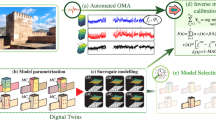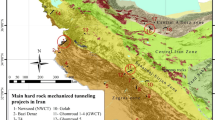Abstract
One of the most important aims of blasting in open pit mines is to reach desirable size of fragmentation. Prediction of fragmentation has great importance in an attempt to prevent economic drawbacks. In this study, blasting data from Meydook mine were used to study the effect of different parameters on fragmentation; 30 blast cycles performed in Meydook mine were selected to predict fragmentation where six more blast cycles are used to validate the results of developed models. In this research, mutual information (MI) method was employed to predict fragmentation. Ten parameters were considered as primary ones in the model. For the sake of comparison, Kuz-Ram empirical model and statistical modeling were also used. Coefficient of determination (R 2), root mean square error (RMSE), and mean absolute error (MAE) were then used to compare the models. Results show that MI model with values of R 2, RMSE, and MAE equals 0.81, 10.71, and 9.02, respectively, is found to have more accuracy with better performance comparing to Kuz-Ram and statistical models.








Similar content being viewed by others
References
Benardos AG, Kaliampakos DC (2004) A methodology for assessing geotechnical hazards for TBM tunnelling—illustrated by the Athens Metro, Greece. Int J Rock Mech Min Sci 41:987–999
Chai T, Draxler RR (2014) Root mean square error (RMSE) or mean absolute error (MAE)?—arguments against avoiding RMSE in the literature. Geosci Model Dev 7:1247–1250
Cover TM, Thomas JA (2012) Elements of information theory. John Wiley & Sons, New Jersey
Cunningham CV (1983) The Kuz-Ram model for prediction of fragmentation from blasting. In: Proceedings of the first international symposium on Rock Fragmentation by Blasting, Lulea University of Technology, Sweden
Cunningham CV (2005) The Kuz-Ram fragmentation model-20 years on. In: Proceedings of the European Federation of Explosives Engineers, Brighton, UK
Dey K, Sen P (2003) Concept of blastability-an update. Indian Min Eng J 42:24–31
Djordjevic N (1999) A two-component model of blast fragmentation. AusIMM Proc (Australia) 304:9–13
Ebrahimi E, Monjezi M, Khalesi MR, Armaghani DJ (2016) Prediction and optimization of back-break and rock fragmentation using an artificial neural network and a bee colony algorithm. Bull Eng Geol Environ 75:27–36
Engin IC (2010) A practical method of bench blasting design for desired fragmentation based on digital image processing technique and Kuz-Ram model. Int J Rock Fragm Blasting FRAGBLAST 9:257–263
Faramarzi F, Farsangi ME, Mansouri H (2013) An RES-based model for risk assessment and prediction of backbreak in bench blasting. J Rock Mech Rock Eng 46:877–887
FréNay B, Doquire G, Verleysen M (2013) Theoretical and empirical study on the potential inadequacy of mutual information for feature selection in classification. Neurocomputing 112:64–78
Gheibie S, Aghababaei H, Hoseinie SH, Pourrahimian Y (2009) Modified Kuz—Ram fragmentation model and its use at the Sungun Copper Mine. Int J Rock Mech Min Sci 46:967–973
Ghosh A, Daemen JJ, Van Zyl D (1990) Fractal-based approach to determine the effect of discontinuities on blast fragmentation. In: The 31th US Symposium on Rock Mechanics (USRMS), American Rock Mechanics Association
Hjelmberg H (1983) Some ideas on how to improve calculations of the fragment size distribution in bench blasting. In: Proceedings of the first international symposium on Rock Fragmentation by Blasting, Lulea University of Technology, Sweden
Hoek E, Kaiser PK, Bawden WF (2000) Support of underground excavations in hard rock. CRC Press. Taylor & Francis group.
Hudson J (1992) Rock engineering systems. Theory and practice. Ellis Horwood, New York
Jahani M, Taji M (2015) Comparison of empirical fragmentation models at the Gol-Gohar iron ore mine. In: 11th International Symposium on Rock Fragmentation by Blasting. The Australasian Institute of Mining and Metallurgy, Melbourne, pp 707–714
Jimeno EL, Jimino CL, Carcedo A (1995) Drilling and blasting of rocks. CRC Press. Taylor & Francis group
Kanchibotla SS, Valery W, Morrell S (1999) Modelling fines in blast fragmentation and its impact on crushing and grinding. In Explo ‘99—a conference on rock breaking, the Australasian Institute of Mining and Metallurgy, Kalgoorlie, Australia
Kou S, Rustan A (1993) Computerized design and result prediction of bench blasting. In: Proceedings of the 4th international Symposium on Rock Fragmentation by Blasting, Vienna, Austria
Kuznetsov VM (1973) The mean diameter of the fragments formed by blasting rock. J Min Sci 9:144–148
Latham JP, Lu P (1999) Development of an assessment system for the blastability of rock masses. Int J Rock Mech Min Sci 36:41–55
Maarefvand P (2012) Report on geotechnical sampling and tests in Meydook mine
Monjezi M, Rezaei M, Varjani AY (2009) Prediction of rock fragmentation due to blasting in Gol-E-Gohar iron mine using fuzzy logic. Int J Rock Mech Min Sci 46:1273–1280
Monjezi M, Bahrami A, Varjani AY (2010) Simultaneous prediction of fragmentation and flyrock in blasting operation using artificial neural networks. Int J Rock Mech Min Sci 47:476–480
Pars olang (2010) Report on mining-geological mapping
Pocock AC (2012) Feature selection via joint likelihood. Doctoral Dissertation, University of Manchester
Raina AK, Ramulu M, Choudhury PB, Dudhankar A, Chakraborty AK (2003) Fragmentation prediction in different rock masses characterised by drilling index. Int J Rock Fragm Blasting FRAGBLAST 7:117–121
Razali NM, Wah YB (2011) Power comparisons of Shapiro-Wilk, Kolmogorov-Smirnov, Lilliefors and Anderson-darling tests. J Stat Model Anal 2:21–33
Reza FM (1961) An introduction to information theory. McGraw-Hill, New York
Seber GA, Lee AJ (2012) Linear regression analysis. John Wiley & Sons, New Jersey
Shapiro SS, Wilk MB (1965) An analysis of variance test for normality. Biometrika 52:591–611
Singh DP, Sastry VR (1986) Influence of structural discontinuity on rock fragmentation by blasting. In: Proceedings of the 6th International Symposium on Intense Dynamic Loading and its Effects, Beijing, China
Spathis AT (2004) A correction relating to the analysis of the original Kuz-ram model. Int J Blasting Fragm 8:201–205
Acknowledgements
The authors are thankful to Meydook copper mine for giving opportunity to collect data and providing information for this research.
Author information
Authors and Affiliations
Corresponding author
Appendix
Appendix
Example 1
Calculation of the weight factor of burden (B) and rock quality design (RQD) on D 80 through mutual information method for five data sets is as follows:
At first, we should calculate the entropy function of parameters. The number of bin is arbitrary. In this example, bin is equal to 5. The values of parameters are as follows:
Entropy
Joint entropy calculation
Mutual information
Rights and permissions
About this article
Cite this article
Ghaeini, N., Mousakhani, M., Amnieh, H.B. et al. Prediction of blasting-induced fragmentation in Meydook copper mine using empirical, statistical, and mutual information models. Arab J Geosci 10, 409 (2017). https://doi.org/10.1007/s12517-017-3189-4
Received:
Accepted:
Published:
DOI: https://doi.org/10.1007/s12517-017-3189-4




